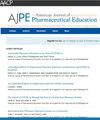Tiered Training and Licensure for the Future of the Pharmacy Profession: Panacea or Pandora's Box?
IF 3.5
4区 教育学
Q1 EDUCATION, SCIENTIFIC DISCIPLINES
引用次数: 0
Abstract
Objective
To summarize the findings of an Academic Leadership Fellows Program debate and to evaluate the affirmative and opposing arguments for implementing a tiered training and licensure model within the pharmacy profession.
Findings
This analysis was conducted as part of the Academic Leadership Fellows Program, where fellows debated current topics in academic pharmacy. Debate participants reviewed contemporary and historical literature on the transition to the all-Doctor of Pharmacy degree, conducted informal polls and surveys of colleagues and key opinion leaders in pharmacy education and practice, and synthesized their findings to assess the potential impact of a tiered training model. The analysis revealed diverse perspectives on the role of tiered pharmacy education and licensure. Proponents and opponents aligned their arguments around three core themes: oversight of the medication use process, economic impacts, and professional identity considerations for all pharmacy professionals.
Summary
In light of current challenges, including weakening employment conditions, professional dissatisfaction, and declining student applicant pools, a comprehensive examination of alternative training models is timely. Although a tiered training and licensure model offers potential solutions, it also presents significant risks. Enhanced integration of pharmacy technician training and credentialing alongside pharmacist education is critical and should be embraced, particularly for advanced technician roles.
未来药学专业的分层培训和执照:万灵药还是潘多拉魔盒?
目的:总结学术领导研究员计划(ALFP)辩论的结果,并评估在药学专业中实施分层培训和许可模式的肯定和反对观点。研究结果:该分析是作为ALFP的一部分进行的,在ALFP中,研究员讨论了学术药学的当前主题。辩论参与者回顾了关于向药学博士学位过渡的当代和历史文献,对药学教育和实践中的同事和主要意见领袖进行了非正式民意调查和调查,并综合了他们的研究结果,以评估分层培训模式的潜在影响。分析揭示了对分层药学教育和许可的作用的不同观点。支持者和反对者围绕三个核心主题进行了争论:药物使用过程的监督、经济影响和所有药房专业人员的职业身份考虑。摘要:鉴于当前的挑战,包括就业条件疲软、职业不满和学生申请人数下降,对替代培训模式进行全面审查是及时的。虽然分层培训和许可模式提供了潜在的解决方案,但它也带来了重大风险。加强药学技术人员培训和资格认证与药剂师教育的整合是至关重要的,应该接受,特别是对于高级技术人员的角色。
本文章由计算机程序翻译,如有差异,请以英文原文为准。
求助全文
约1分钟内获得全文
求助全文
来源期刊
CiteScore
4.30
自引率
15.20%
发文量
114
期刊介绍:
The Journal accepts unsolicited manuscripts that have not been published and are not under consideration for publication elsewhere. The Journal only considers material related to pharmaceutical education for publication. Authors must prepare manuscripts to conform to the Journal style (Author Instructions). All manuscripts are subject to peer review and approval by the editor prior to acceptance for publication. Reviewers are assigned by the editor with the advice of the editorial board as needed. Manuscripts are submitted and processed online (Submit a Manuscript) using Editorial Manager, an online manuscript tracking system that facilitates communication between the editorial office, editor, associate editors, reviewers, and authors.
After a manuscript is accepted, it is scheduled for publication in an upcoming issue of the Journal. All manuscripts are formatted and copyedited, and returned to the author for review and approval of the changes. Approximately 2 weeks prior to publication, the author receives an electronic proof of the article for final review and approval. Authors are not assessed page charges for publication.

 求助内容:
求助内容: 应助结果提醒方式:
应助结果提醒方式:


